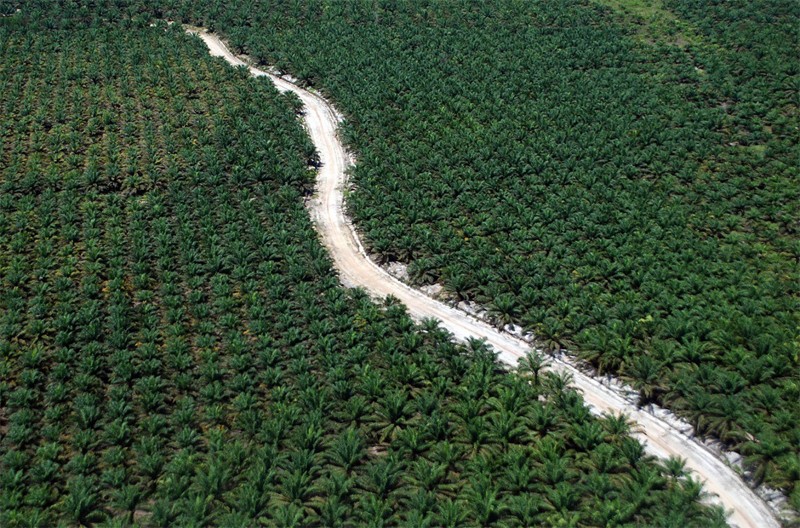Indonesia's exports to still rely on primary commodities: HSBC
Change Size
 An aerial picture of a palm-oil plantation in Dumai, Riau, on Aug. 9. (Antara Photo/Rony Muharrman)
An aerial picture of a palm-oil plantation in Dumai, Riau, on Aug. 9. (Antara Photo/Rony Muharrman)
D
espite Indonesia’s efforts to climb up the value chain, the country’s exports will remain dependent on primary commodities in the long term, a trade report says.
Until 2020, the country’s overseas shipments will be largely dominated by agricultural produce, mineral fuels and raw materials, according to the HSBC Trade Report published last Friday. These types of items will also make up nearly 60 percent of overseas shipments from Southeast Asia’s largest economy in the later period from 2021 to 2030.
“Although higher value-added sectors like chemical, industrial, machinery and wood manufactured [commodities] show relatively strong growth over the long term, the top five export goods will continue to reflect Indonesia’s traditional strength in the primary sector,” the report said.
In a change from the current situation, India and China are set to become Indonesia’s top export destinations by 2030, replacing the United States and Japan, it said.
At present, China and India are the third and fifth biggest markets for the country’s shipments, which mostly comprise coal and palm oil.
The report particularly underlined that India may need mining and primary commodities to support its economic expansion in the next five years.
Indonesia has struggled to rebuild its manufacturing industry since the 1997-1998 financial crisis, before which the sector had always expanded robustly and mostly outpaced the country’s economic growth.
Poor infrastructure, expensive energy costs and red tape have been among the major stumbling blocks that have prevented Indonesia from reaching its potential.
A commodity boom in the past decade provided leeway to boost exports despite a still weak manufacturing industry.
Indonesia’s manufacturing industry expanded only by 4.25 percent last year, which was lower than the economic growth of 4.79 percent, according to the Industry Ministry. It contributed 20.84 percent to gross domestic product (GDP), of which 18.8 percent was generated by the non-oil and gas industry.
In the short term, as commodity prices start to head upward and global demand is on its way to recovery, there will be stronger interest for Indonesia’s exports in the next few years, the report said.
Center of Reform on Economics (CORE) Indonesia director Mo-
Dependence on primary commodity exports will continue until 2030 India and China set to become Indonesia’s top destinations by 2030, replacing the US and Japan
hammad Faisal said that the export of manufactured goods may remain stagnant in the future, hampered particularly by expensive energy and high logistics costs. Therefore, agricultural products might still become the driver of overseas shipments.
“The downstream agriculture industry must be strengthened because manufactured goods have higher value,” Faisal told The Jakarta Post.
Indonesian Institute of Sciences (LIPI) economist Latif Adam shared a similar view, saying that agricultural produce would likely dominate exports in the next few years because of its strong presence domestically.
“However, we need to enhance the downstream agriculture industry. It is hoped that we not only export crude palm oil [CPO], for example, but its derivatives, such as margarine or cosmetics,” Latif told the Post.
Processed goods, he said, have lower volatility compared to commodities, the prices of which fluctuate according to movement in the international markets.
Separately, the National Development Planning Agency (Bappenas) said that it aimed to make Indonesia’s manufacturing industry a key part of the global supply chain in the future, although it realized that would take a long time.
“By becoming part of the global supply chain, we can reduce our dependence on commodities vulnerable to global price movements,” National Development Planning Minister Bambang Brodjonegoro said Saturday as quoted by Antara news agency.
The potential industrial sectors that could be fostered include those that are natural-resource, labor-intensive, consumer goods and automotive based, he said.
The HSBC report also noted that similar to the export pattern, Indonesia’s import profile would also remain relatively unchanged in the designated time frame.
In total, about three-quarters of all growth in the importation of goods from 2021 until 2030 will be driven by the purchase of chemicals, transportation equipment and machinery.
“Furthermore, Indonesia will continue to import large quantities of petroleum products, despite attempts to encourage local producers to invest in processing plants in Indonesia,” the report said.









